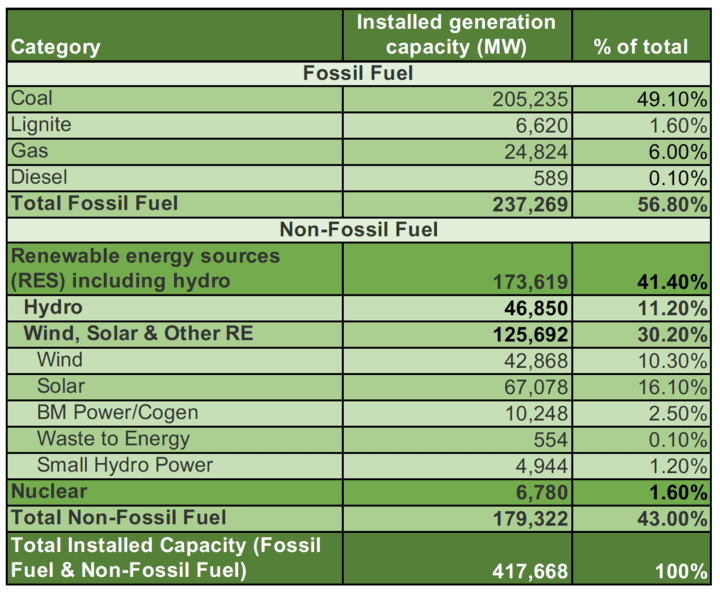Analysis of Performance Degradation of PV Modules
Solar energy is a clean and environmentally friendly source of energy. It can also help in reducing the global carbon footprint and mitigating the impacts of climate change. Due to the positive aspects of solar energy, its demand is growing exponentially.
Photovoltaic (PV) modules are undoubtedly the most significant component of a solar power system. PV modules of various technologies are now accessible in the market, thanks to advances in technology. Polycrystalline silicon (poly-Si), monocrystalline silicon (mono-Si), thin-film, and mono-PERC (passivated emitter and rear contact) are some of the most-often-utilized modules. Yet, continuous research and development (R&D) operations are being carried out to improve the efficiency of various technologies, such as mono-PERT (passivated emitter rear totally diffused), heterojunction (HJT), quantum dot, perovskite, and more.
To keep an asset performing at its optimum levelized cost of energy (LCOE) and to extract maximum return on investment (ROI) out of it, a PV module’s health and its regular checkup at defined intervals is of utmost importance. It should be understood that PV modules are very delicate, and hence, vulnerable to defects. Even a crack of a few millimeters in a PV module may cause power output to drop drastically over a span of time.
This article comprehensively covers the degradation analysis of PV modules. It deals with factors affecting performance degradation of PV modules, which includes inherent as well as anthropogenic factors.
The article is targeted for solar asset owners and industry experts in the solar domain. It explains do’s and don’ts for handing of PV modules, whether during installation, operation, or maintenance of a solar plant. Adhering to some basic practices, as explained in the article, the defects in a PV module can be minimized, and hence, performance of PV modules can be improved.
At the end, some diagnostic tests have been recommended to be performed on solar PV modules along with applicable International Electrotechnical Commission (IEC) standards. These diagnostic tests help in understanding of condition of PV modules and early detection of abrupt degradation/defects, if any. The findings in this article are based on the testing experience of Mahindra Teqo on more than 7 GW of solar assets, spreading across India (see sidebar) and abroad.
| India’s Growing Solar Power Sector
As of June 30, 2023, installed solar capacity in India was 70,096.83 MW, which constitutes about 16.1% of the total installed generation capacity in India, which includes both fossil fuel and non-fossil-fuel-based power plants (Table 1).
As India is moving ahead strongly with the vision of “green environment and clean energy,” the Central Electricity Authority (CEA) stated that generation from renewable energy sources might increase to 44% as early as 2029. CEA has also estimated that by 2029 or 2030, India’s solar capacity could surpass the nation’s thermal generation capacity. |
Understanding PV Module Degradation
A typical PV module is expected to degrade by 2% to 3% in its first year of operation, and 0.5% to 0.7% from year two of operation onward. Higher degradation in the first year of operation is due to light-induced degradation (LID).
The presence of defective boron-oxygen complex in the wafer used during the manufacturing of PV cells is the main reason for LID. It affects silicon wafers produced through the Czochralski process. After a few hours of PV module operation in sunlight, power stabilization occurs, and hence, a lower warranted degradation rate is observed from the second year of operation.
Most of the module manufacturers provide a linear performance warranty for 25 years of operation. However, now-a-days, there are growing numbers of module manufacturers offering 30 years of performance warranty on their modules (Figure 1). However, due to anthropogenic reasons, a PV module may degrade at an accelerated rate. Modules made up of N-type substrate exhibit lower degradation in performance as compared to that of P-type.

Classification of Defects in a Typical PV Module
Defects in a typical PV module can be broadly classified into three categories:
- Infant defects
- Mid-life defects
- Wear-out defects
The bath-tub curve (Figure 2) shows the probability of failures over the operating life of a PV module.
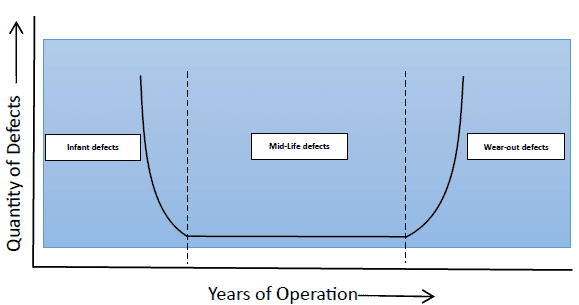
Infant Defects. Infant defects are often attributed to poor design or manufacturing errors. These can be reduced by effective process control. However, as previously noted, in the initial years of operation of a PV module degradation rates tend to be slightly on the higher side than during the rest of the operating life, due to stronger influence of LID. Potential-induced degradation (PID) may also influence the degradation rate during the initial years of operation, but at a lower rate in normal circumstances.
Generally, glass breakage, contact failure in junction boxes, loose frames, and some other defects are observed during the initial years of operation. For a typical solar module, infant defects occur within one to two years of operation.
Mid-Life Defects. Mid-life defects are often random defects or defects arising due to technology defects. Stronger PID, diode failure, cell interconnection breakage, and degradation in glass are some of the common mid-life defects.
Wear-Out Defects. Wear-out defects occur when the working life of a PV module is near its end or when the power output of a PV module falls below 70%–80% of its nominal value. Discoloration of ethylene vinyl acetate (EVA) sheet, discoloration of PV cells, and delamination are the most common wear-out defects (Table 2). Ideally, wear-out defects should occur after completion of the warranty period.

Factors Contributing to Performance Degradation of PV Modules
Broadly, there are two factors that may impact performance of PV modules and contribute to their degradation. These are inherent factors and anthropogenic factors.
Inherent Factors
Thermal Cycling Induced Degradation. When a particular PV module is subjected to different temperature gradients in various climatic conditions, it may exhibit degradation in its performance. This is because of the different temperature coefficients of materials used during fabrication of a PV module. Cell interruptions, defects at soldering joints, and discoloration of encapsulant are the most common defects that arise due to thermal cycling. Using adhesive and primers having higher stability against varying thermal conditions, use of automated soldering machines, testing PV modules as per IEC 61215 to identify modules that are prone to degradation under thermal cycling, and using materials having higher thermal stability may be options employed by original equipment manufacturers to mitigate this type of degradation. Adhering to proper cleaning cycles, ensuring no shadows at PV modules, and optimizing electrical connections are some of the methods that are recommended to be followed at PV plants.
Ultra-Violet Induced Degradation (UVID). PV module performance is adversely affected by UV light due to generation of surface defects. Recent studies show that emerging higher performance cell technologies, such are p-PERC and n-PERT cells, are more vulnerable to degradation due to UV light.
Decrease in Performance Due to Degradation of Anti-Reflective Coating (ARC). ARC is widely used to increase light transmission through a PV module. Most commonly used ARC is a thin layer of porous silica deposited by chemical processes over the PV module surface. A layer of ARC with a thickness of about 100 nanometers (nm) to 120 nm may increase the power output by 2% to 3% (Figure 3). However, as the age of a PV module progresses and ARC layer thickness is scratched or reduced, which may cause PV modules to exhibit a decrement in power output that is higher than expected.
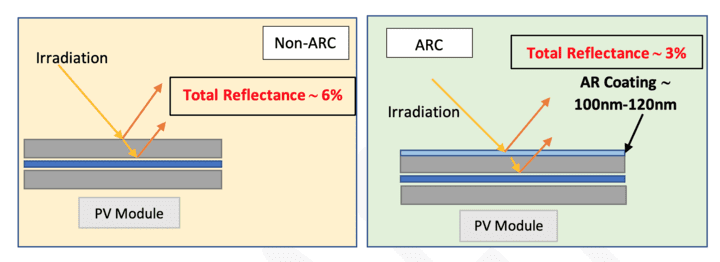
Decrease in Performance Due to LID and LeTID (Light and elevated Temperature Induced Degradation). As previously mentioned, LID is a loss in performance of PV modules that occurs during initial exposure of PV modules in sunlight. On the other hand, LeTID accounts for loss in performance of PV modules after hundreds of hours of exposure in sunlight when operating temperature is more than 65 degrees Celsius.
Decrease in Performance Due to Degradation of EVA Sheet. EVA sheet prevents air and moisture from reaching PV cells, and hence, prevents subsequent degradation. However, under prolonged UV exposure and adverse weathering conditions, EVA decomposes into acetic acid, which makes EVA sheet yellow. The change in color of EVA sheet changes primarily short circuit current (Isc) and series resistance (Rs) parameters of the PV module, which in turn decreases power output.
Anthropogenic Factors
Wrong Practices During EPC. Improper selection and use of clamps (Figure 4), and over tightening of fasteners (Figure 5), are the most common concerns during the engineering, procurement, and construction (EPC) phase. In fact, these two factors account for most glass breakage of PV modules. Moreover, these factors become more dangerous in the case of frameless modules. Glass breakage can contribute significantly to a decrease in performance of PV modules, if not taken care well in time.
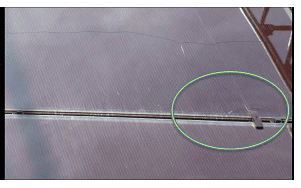
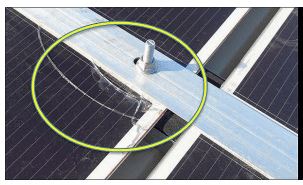
Wrong Operations and Maintenance Practices. Wrong site practices and non-adherence to recommended cleaning cycles at PV plants contribute to a decrease in performance of PV modules. These two factors may lead to the formation of hot spots, and hence, over-heating of PV modules.
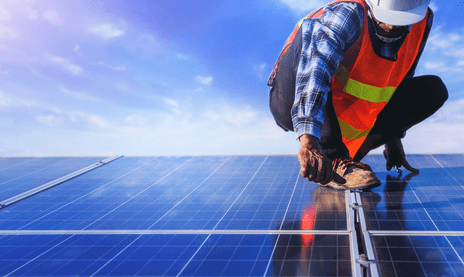
Health Check-up of PV Modules
As explained, solar PV modules are very delicate and highly prone to defects. Most of these defects cannot be seen through naked eyes. Hence, a routine health check-up of PV modules through sophisticated equipment and skilled engineers is recommended on an annual basis, or at least biennially, by solar asset owners. Some of the diagnostic tests recommended to be performed on solar PV modules of an operational solar plant are noted in Table 3.
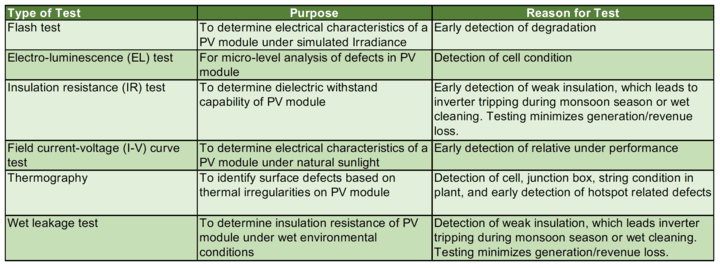
Conclusion
Solar energy is regarded as one of the most versatile and easily available power sources. Over the last few decades, it has provided an outstanding opportunity for investment amongst corporates.
PV modules, being the most important part of solar generating systems, are pretty low maintenance. However, as said, nothing is fool-proof, hence, problems with PV modules are bound to happen. But the best part is that deficiencies can be noticed easily by observing the way a solar system is functioning.
With proper maintenance of PV modules, adhering to proper do’s and don’ts, and performing routine diagnostic tests with proper analysis of test results can not only help owners in minimizing the failures with PV modules, but it can also extend the operating life of the modules. In some cases, it has been observed that the operating life of PV modules has increased substantially if the health of PV modules is well taken care of.
—Satish Pandey is head of Analytics and Advisory, Sumit Kumar is a senior engineer, Rakshita Mhatre is a senior engineer, and Tushar Singh is a testing engineer, all with Mahindra Teqo Pvt. Ltd.
